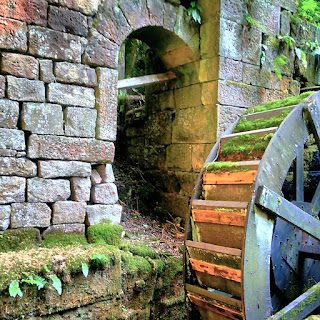THIS SITE IS ON PRIVATE PROPERTY..
The following images were obtained through special permission..
Apart from evidence of early ironworks and smelting, the main industry in Cragg had always been agriculture. Then agriculture and cloth - the rugged dual economy...
Having a good supply of water from the moors, Cragg was always a likely home for industry based on water power. From mid 1700 onwards, water then steam power, and combined water wheel and steam engines began to dominate the valley , the cloth mills began to appear around 1740..
Having a good supply of water from the moors, Cragg was always a likely home for industry based on water power. From mid 1700 onwards, water then steam power, and combined water wheel and steam engines began to dominate the valley , the cloth mills began to appear around 1740..
The Paper Mill,also known as Cragg Mill, straddled Cragg Brook / Elphin Brook at Cragg Vale.
Access from the main Cragg Road was by way of a steep track, In its early years, the mill was run by John Greenwood – where he was involved in the manufacture of paper and wool cards – and then jointly with his father-in-law Richard Hinchliffe.Today, only the ruins of the mill remain. A bridging platform, that supported part of the mill , stands above the brook.The mill pond for the waterwheel can still be found nearby. I was also told most of the land around here is on PRIVATE PROPERTY,
Access from the main Cragg Road was by way of a steep track, In its early years, the mill was run by John Greenwood – where he was involved in the manufacture of paper and wool cards – and then jointly with his father-in-law Richard Hinchliffe.Today, only the ruins of the mill remain. A bridging platform, that supported part of the mill , stands above the brook.The mill pond for the waterwheel can still be found nearby. I was also told most of the land around here is on PRIVATE PROPERTY,
moreover, there are a number of potential sinkholes around the area caused by underground watercourses . The waterwheel has been restored over the years, and may have been built in the early 19th Century..
This narrow culvert is where the outflow of the wheel went back into Elphin brook..
Evidence of restoration
Archway looking towards the direction of Paper Mill Cottages..
Varied angles of the bridge..
The Sections below were part of the mill

















































I have read in the past that this waterwheel was homemade (possibly from extant metalwork) by a previous owner. It certainly looks homemade and not like a normal, heavy-duty waterwheel… I’m only saying this as a point of interest, not trying to argue :) :)
ReplyDeleteYou are right, the landowner told us the previous owner attempted a revival...more for aesthetics than functionality.Some of the fittings spindles etc were original..but in a state of partial disintegration..Thanks for your reply..👍
ReplyDelete